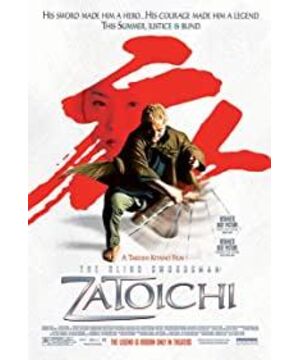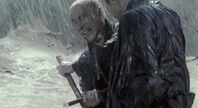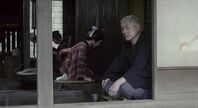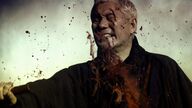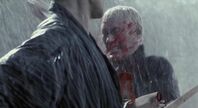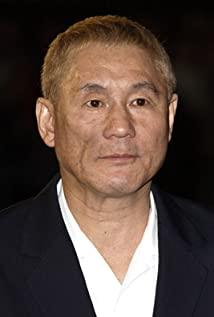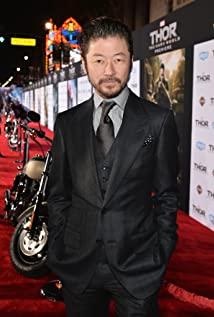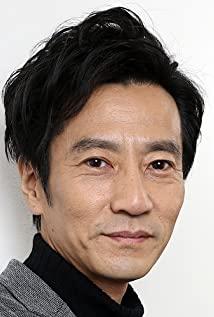I heard that Japanese audiences have jointly protested, worrying that Kitano Takeshi will destroy the city of Zato. After watching this film, I feel that this kind of worry is too much... Just like
Kitano Takeshi's previous films, a strong personal style fills the screen. He abandoned the color shooting technique and replaced it with the main tone of earthy yellow, which aggravated the age of the entire film. Despite the lack of colors, the overall beauty comes out with the costume design of the daughters of Yohji Yamamoto and Akira Kurosawa.
Compared with the image of "fat monk" created by Shintaro, Kitano's image of Zatoichi itself has a great contrast. First of all, the appearance is very eye-catching, with short golden hair and a basket-colored samurai suit. Exquisite cane sword... This subverts most people's imagination of the blind man. However, as soon as the Zato City moved, these eye-catching outfits were immediately neutralized by Takeshi Kitano's habit of tilting his head and walking style. Between the movement and the quiet, Zatou City also changed at two extremes. For a while, he was just a blind man, he likes to bet on cards and can massage... After a while, he became a fast swordsman again, and his shots were extremely fierce. I especially like the swallowing action that Takeshi Kitano added before he drew his sword in Zato City. This action is just like the expression in the eyes of ordinary people, and it is an expression of psychological fluctuations in Zato City.
The way that Takeshi Kitano gave Zato City's character is to use thick lines to match the small area of the finishing touch. The title is very straightforward. As soon as it came up, Zatoichi, who was still sitting and resting, entered the battle instantly, seized the sword and fought back cleanly. In the future, some fighting scenes continued the violent aesthetic style of Takeshi Kitano, and with the blood spray effect made by CG animation, it didn't take much effort to let people understand the strong desire to fight back in the character of Zatoichi, just like in a tavern. In that scene, the moment Hattori pushed the sword out of its sheath, the sword of Zatoichi was already on top. But when Zatoichi learned about Hattori's swordsmanship, he asked himself how he would win against him in the dark and deliberately opened his eyes when facing Toba Kishi at the end. These two details still portrayed his rough and fine sides.
Of course, the most exciting place appeared in the duel scene of Zato City and Hattori. The scene of masters' moves must be kept minimalist and end the battle with one blow, but how to bring it with as little action as possible in such a short time More sensory stimulation and imagination space for the audience is a difficult problem to solve. But Kitano Takeshi is very smart. He fills the time with Hattori's mental imagination, which is distracting. It was followed by the lightning strike of Zatou City, which was too fast and too exciting. It's like two people are playing chess, although in the end they are all moving a chess piece to checkmate others, but the tricks that have been in the mind in the process are the key points. Hattori turned backhand to shoot the sword, and Zatoichi flipped hands at the last moment is really memorable.
The other highlights of this movie are:
1: Xiaowei’s dancing scene is a combination of reality and reality. The scenes are constantly switching between the adult Xiaowei and the young Xiaowei. The transition of time and space makes people feel a little trance for a while, matching the face of the teenager. The seriousness and the calmness of adulthood, an ordinary Japanese dance brings an extraordinary impact.
2: A film about a blind swordsman. Takeshi Kitano has worked very hard on the soundtrack, especially the percussion sound throughout the film. From the sound of hoeing at the beginning to the tap dance-like choreography scene, there is rhythm everywhere. The percussive sound, such auditory stimulation and the weakened image color allow all audiences to enter the Zato City, the world that blind people experience.
3: Kitano Takeshi’s unique sense of humor: The fool who always thinks about being a samurai, the idle upstart, and the last sentence that shakes his burden: “No matter how big your eyes are, invisible means invisible”... …Are all interesting.
The classic is the inheritance of the classic, and the classic is the betrayal of the classic. Kitano inherited well, but betrayed even more beautifully!
View more about The Blind Swordsman: Zatoichi reviews


